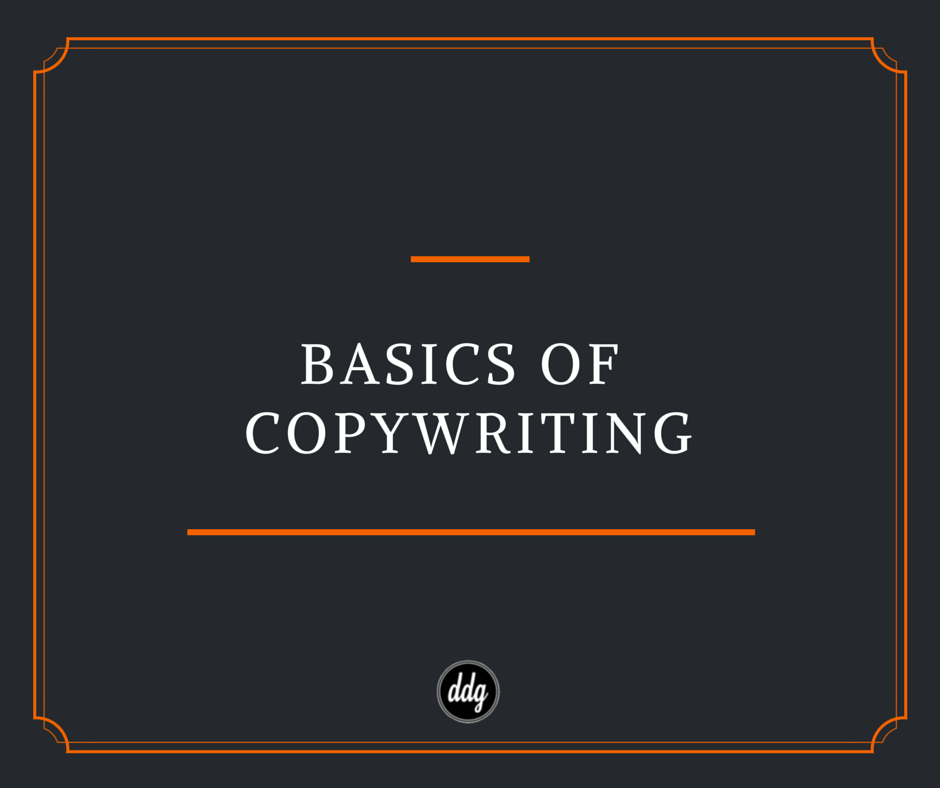Basics of Copywriting

Overview:
Welcome to Copywriting 101, please take your seats.
We’ve heard and discussed how content can make or break you in the digital world. Having compelling words, pictures, videos, and other media is essential for attracting and engaging your online audience and converting them into loyal customers. An often overlooked component of this endeavor are the words, or copy, that you use. For the uninformed, copywriting is defined as the ‘act of writing text(copy) for the purpose of advertising or marketing a product, business, person, opinion, or idea.’ Word choice, the quality of writing, and your brand ‘voice’ all depend on the skills of a good copywriter. Great copy can help your online presence by increasing SEO, encouraging conversion, and increasing loyalty through a unified brand voice. At its essence, copywriting is persuasive writing, and whether you’re persuading a potential customer to buy your product, or persuading them to engage with your content, great copy is successful in influencing your audience’s behavior by tapping into their wants/needs.
Before You Write:
Most of the work in creating great copy is done before you even type/write a word. Understanding the topic you’re writing about, who you’re writing for and to, and planning how you’ll present the content is absolutely imperative to success. Otherwise you’re just hoping something you write sticks. Poorly prepared content also contributes to a dissonant brand voice, which makes it hard for your audience to develop feelings about your brand and become loyal customers.
For starters, you’re going to want to know your audience. The content is for them, to engage them, and to influence them. Writing with a full understanding of the wants and needs and passions of who will read your content will be very helpful in crafting something that they will want to read and respond to.
Also important in your pre-writing process is determining your objectives and USP (unique selling proposition). Your USP is something that competitors do not or will not offer that your business does really well. It’s the biggest reason that customers need to hear to choose your business and not your competitor’s. When you do get to writing, you’ll build your content structure around those key messages.
It’s important to have an objective or purpose with what you want your audience to do with your copy. If it is not clear to you, then it won’t be clear to them.
Copywriting:
Whether it’s a marketing email, blog post, sales copy, website page copy, or anything else, what you lead off with is important in capturing your audience’s attention and keeping them reading long enough to deliver your USP/key message. This could be the lede of an article, the subject line of an email, or even the first few words of a Twitter post. With copywriting, it’s different from creative writing or research writing in that you want to get to the point as quickly as possible. Cut to the chase. The longer you take talking about what you’re going to talk about, the more interest you’ll lose. Tell them why your purpose and why they want to keep reading as soon as possible. For emails, this will be the headline. For articles/page copy, the first sentence. Answer the question: “What’s in it for me?”
Go after your audience’s interests, generate curiosity, or make an interesting promise that can only be fulfilled by reading the full body of text (‘10 Things that Great Copywriters Do: Number 9 is Our Favorite!’), and you’ll convince your audience that what you have to say is worth their time and attention. Common advice in copywriting is to either persuade, inform, or entertain your audience. Let them know which one you’ll be doing.
Now we’re in the meat of the article. The offer. The ‘10 Things’. The key message. Now that you’ve got your audience’s attention, you need to deliver on your promise of making it worth the time and effort to listen to what you’ve got to say. Deliver your key message with the concepts of usefulness, urgency, uniqueness, and specificity in mind. People want things and information that are relevant and useful to their special wants and needs, delivered in a way that they are familiar with. What this means is keeping your writing clean and concise and with a brand voice and language that they are intimate with. The difference in tone and language that you’ll need to take when writing for skateboarders is vastly different to accountants (unless you’re writing for skateboarding accountants). Using ‘slang’ can prove useful in relating to your audience and showing that you understand their wants and needs. However, if your goal is to acquire new customers, be wary of assuming they’ll know your industry’s language, as that will only serve to alienate them.
Sell benefits, not features. People don’t want to buy a website, they want to reach and convert more customers. By telling your story right, you convince them that they’re not buying a product, they’re buying a solution to a want/need that they have.
Write in an active voice by avoiding past tense. It creates urgency and excitement.
Testimonials increase trust. Word of mouth is still the strongest form of marketing because it shows trust in a company to help customers solve their problems. Using them where appropriate will help influence your reader’s behaviors. Avoid noncommittal words like ‘wish,’ ‘hope,’ ‘but,’ ‘maybe,’ and ‘try’ for the same reason- these words decrease the trust in your company.
Don’t be vague. Make your reader aspire and imagine life with your product. Create a concise, clear, and compelling call to action. It’s all of these little things that contribute to making your copy successful. Paying attention to everything in your copy is essential for influencing behavior.
After You Write:
You’ve finished your piece. It’s all ready to get shipped out and start converting readers into customers more loyal than fans of Apple products right?
Think again.
After writing your piece, there’s still one more ingredient to add to the copywriting soup, and that’s proofreading. Proofread, again and again. And again. As many times as it takes. Making sure your copy is factually and grammatically correct, possesses great rhythm and clarity, and creates a great emotional and psychological impact. It’s important to make sure your content has been written with all the prior criteria in mind, and optimized to obtain whatever goals and objectives you’ve set for writing the content in the first place. It’s always a good idea to get extra eyes on it to proofread and offer recommendations. In another universe, we’d all be perfect copywriters.
Of course, there’s the publishing. There’s a saying “the medium is the message.” The media in which you publish your content is almost as important as the content itself. Making sure your key messages get to those who need to see it vital, so doing your research on what media channels your target audience frequents most is very central to your success.
After you publish, you want to analyze the results. Did people engage with your writing? Did your content convert your qualified leads? Or did it flop? By tracking views, conversions, and engagement, copywriters and marketers have enough tools to determine what’s working in an advertising/marketing campaign and what isn’t. By isolating the problem with either of those three areas, you can re-work your content until you find success. Marketing, content writing, and advertising aren’t exact sciences, but with enough attention to detail and data, we’re able to make adjustments to increase our odds at success.
Final Words:
I have to apologize class. I have tried to stick an entire subject into one 1000 word article. There are most assuredly, things that I have missed or only briefly mentioned that deserve a whole article just on the discussion of that topic (Selling benefits and not features, for example). What we have covered are things that you should consider before writing, while you’re writing your copy, and after you’ve finished your copy. The importance of proper preparation, detailed execution, and diligent analysis of your copy cannot be understated. At its essence, those three things are your keys to success in delivering your message to your audience. Perfecting each stage of the copywriting process is something that takes time and effort, so be sure to check out the resources below for more information on how to be a great copywriter.
The most important tip I have for you is to have fun. Finding your passions (whether it’s writing or something else) and getting good at them is more fulfilling that pouring time into something that you could care less about. The best copywriters absolutely love writing, and that’s why they’re great at it.
Resources:
Here for web design and development? Click Here.
